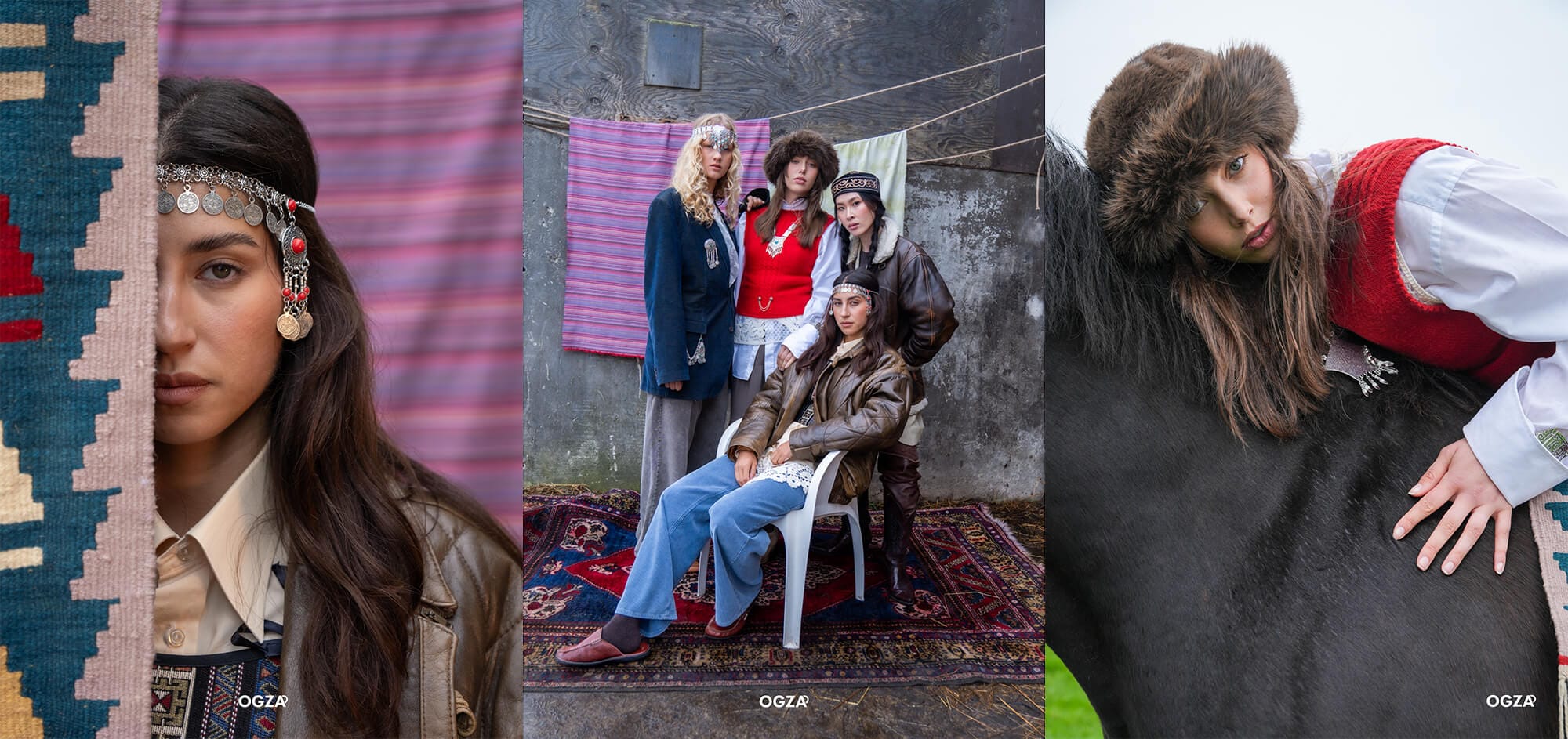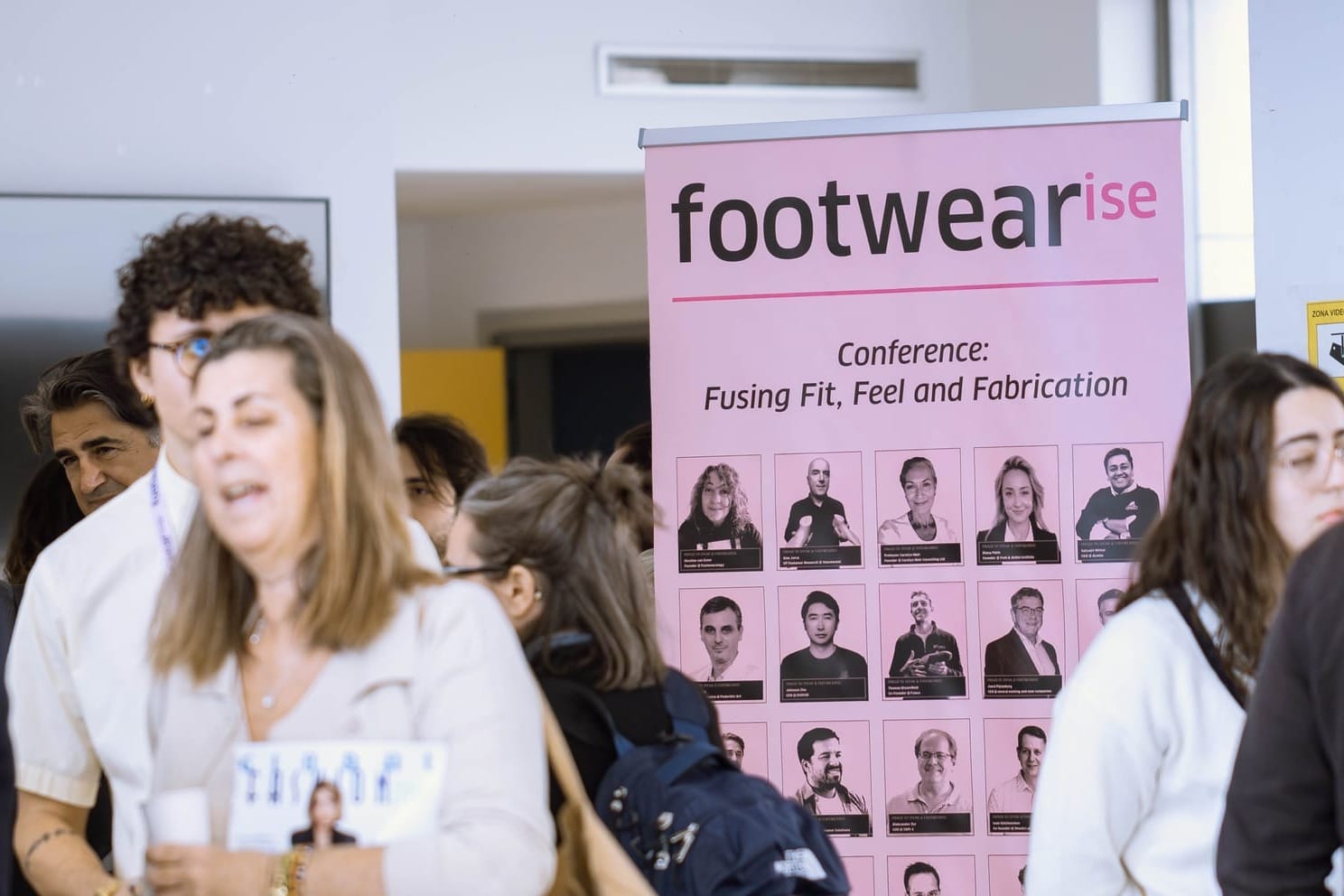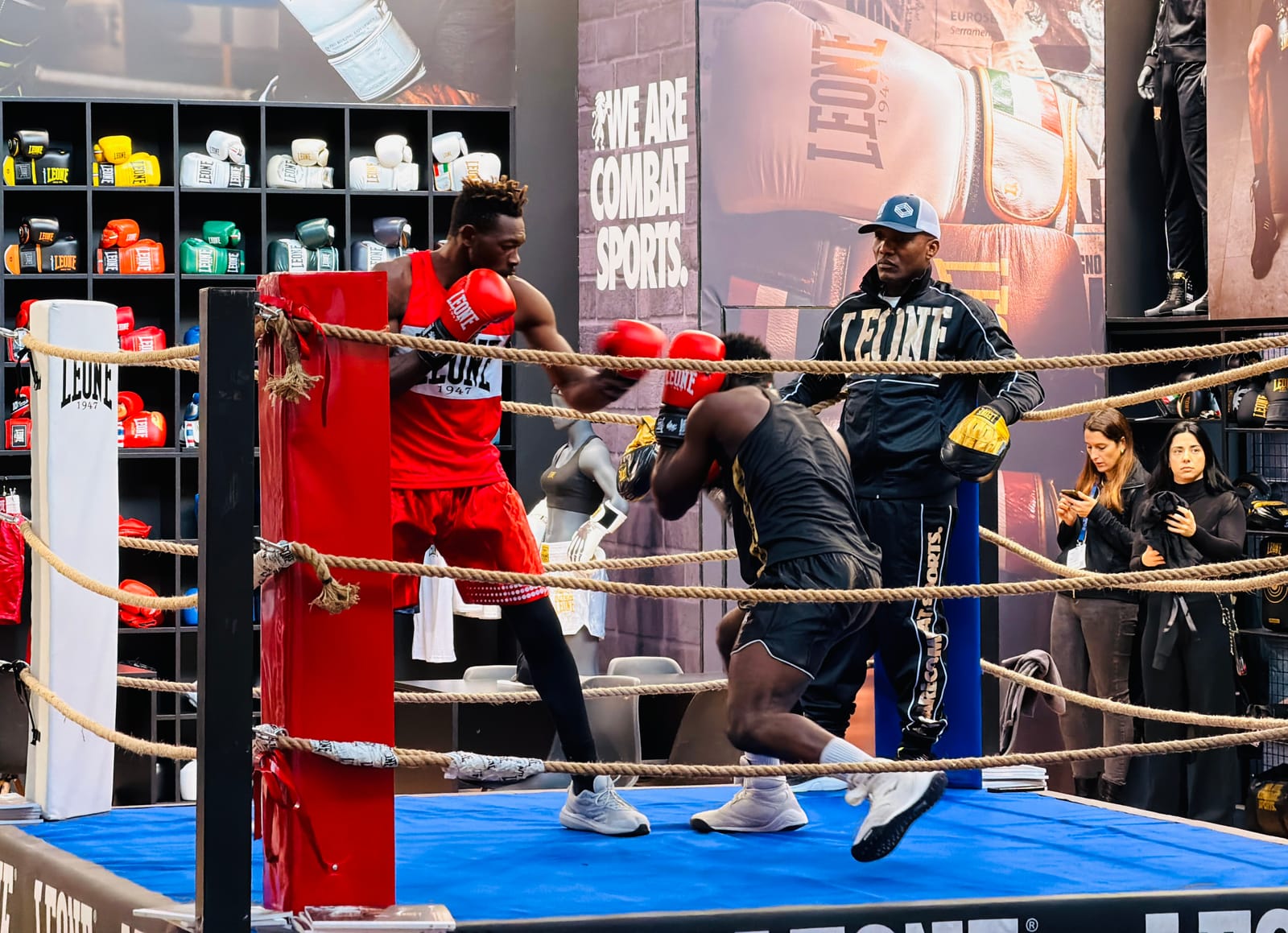What does branding look like when it’s designed for meaning - not metrics?
At AMFI, the answer isn’t just found in a sleek logo or marketing campaign, but shaped through a deeper interrogation of culture, identity, and emotional resonance. In the Fashion & Branding programme, students are taught to think beyond the commercial, learning to translate complex social narratives into meaningful brand experiences across digital and physical touchpoints.
I got a powerful glimpse of this during AMFI NEXT, their end-of-year graduation showcase, where this year’s Fashion & Branding cohort unveiled work that felt as personal as it was strategic. These projects included immersive stories, speculative futures, and unapologetic acts of cultural commentary. From intergenerational e-commerce to Afrofuturist digital fashion, the projects pushed the boundaries of what branding can do, and who it can be done for.
From this thought-provoking mix, I selected four graduates whose radically different approaches offer a compelling snapshot of how tomorrow’s brand thinkers are rewriting the rules. Whether decoding diasporic identity, making tech feel human, or reimagining heritage through new media, each shows how branding today is so much more than selling; it's about storytelling with substance, soul, and strategy.
- Maria Nogueroles x Entre El Metal Y La Memoria – Designing Digital Intimacy for 'The Matriarchs'
For Maria, branding is as much about storytelling as it is about who gets to be included in them. That belief sits at the heart of Entre El Metal Y La Memoria, their self-initiated graduation project - an innovation proposal for Spanish luxury jewellery house Joaquín Berao. A deeply personal concept, it reimagines the digital shopping experience for an often-overlooked demographic: older women.
''I was thinking of my grandmother - elegant, intelligent, curious - and how she always felt there was an invisible boundary between herself and the digital world.''
This insight became the seed for a new kind of e-commerce platform: one that makes digital feel tactile, elegant, and emotionally resonant for women aged 65–85, the audience Maria affectionately calls 'The Matriarchs'.
Guided by deep research and lived experience, Maria designed a senior-friendly shopping journey that favours clarity, trust, and simplicity. Working with IT specialist Sergi Giner, Maria developed 3D visualisers of Berao’s sculptural pieces, allowing users to rotate and examine them in detail. But this was more than just showcasing craft; it was about creating confidence and connection for users often excluded from online retail.
''94.8% of the women I surveyed said they wouldn’t buy jewellery online; not because they weren’t interested, but because the experience wasn’t built for them.''
So Maria took it a step further: developing a proposed immersive VR jewellery workshop hosted at Madrid’s Museo Reina Sofía, where women would explore the collection in a gallery-like setting. For those unable to use VR due to health limitations, Maria built a 2D alternative, a thoughtful nod to accessibility that kept the experience inclusive.
These ideas were the result of tech exploration, as well as empathy. “I studied my grandmother closely. What she reads, where she goes, how she moves through the world.” That mindset shaped every touchpoint: minimal navigation, large images, and a tone of quiet luxury that respected the user’s sophistication.
In a market obsessed with Gen Z and emerging tech, Entre El Metal Y La Memoria is a quiet revolution.
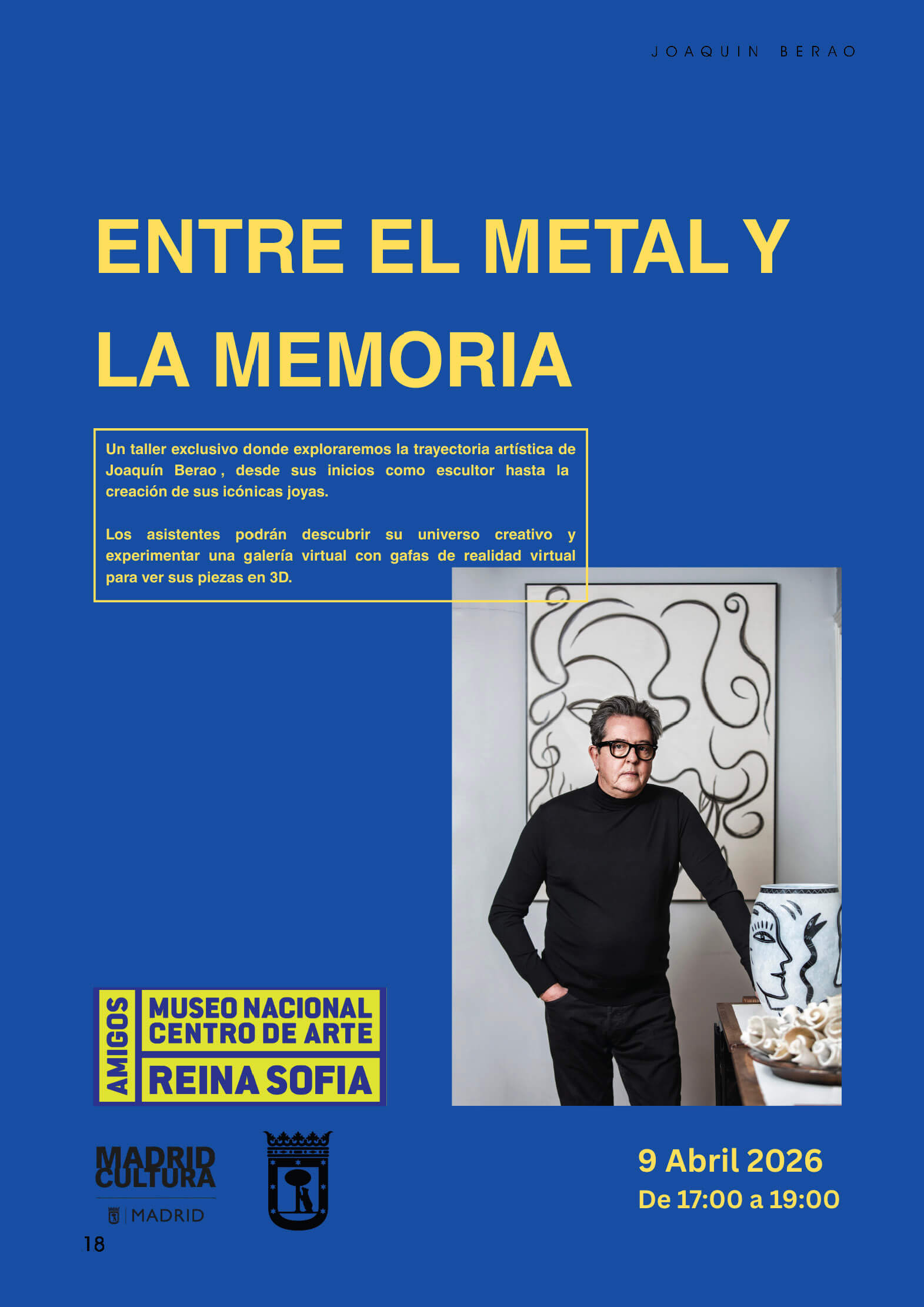
It reminds us that innovation isn’t about chasing the next big thing, but about designing for meaning. Maria proves that luxury can evolve into something more inclusive, intergenerational, and emotionally intelligent.
And Maria is just getting started. Next, she hopes to dive deeper into digital design, UX/UI, or brand strategy, continuing to bridge tech and emotion, and crafting brand experiences that don’t just look good, but feel right.
Connect with Maria here.
👉 Watch another example of Maria's product page
2. Aslinur Gün x OGZA - Reclaiming Cultural Complexity Through Fashion
For Aslinur, branding isn’t about trends - it’s about truth. With OGZA, her graduation project and self-initiated brand, Aslinur set out to challenge the narrow and often stereotyped portrayals of Turkish identity in Western fashion. What emerged is a deeply considered creative platform that bridges past and present, Central Asia and Europe, heritage and innovation - all through the lens of fashion.
''Turkish culture lives in Turkey, yes, but also in Kazakhstan, Turkmenistan, Uzbekistan, Uyghur regions, and beyond. OGZA is about stitching that bigger story back together.''
At its core, OGZA is a mission to reconnect people, not just with each other, but with the overlooked roots of Turkish culture that stretch far beyond modern-day borders. Rather than reducing culture to aesthetics, Aslinur used digital tools to build a brand rooted in storytelling, authenticity, and unity. From typography inspired by nomadic motifs to colour palettes grounded in nature, OGZA’s brand identity merges clean modern design with deep cultural research.
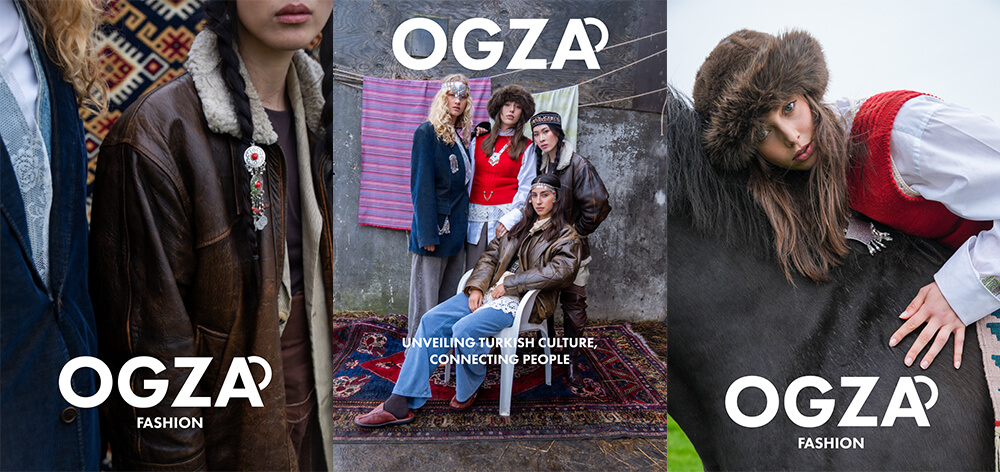
Images of the OGZA Collection; Photo Credit: Coulproductionss / MUAH by urbangems.official
But what OGZA isn’t, is nostalgia; instead, it’s a forward-facing movement. Through Adobe Creative Suite and iterative testing on digital platforms, Aslinur built a concept that could live in today’s fashion world without losing its soul. Every element was designed with intention: to make Turkish culture more visible, more nuanced, and more deeply understood.
''These days, we often focus on the visual surface - what looks good - but forget to ask what it means. OGZA is here to bring that meaning back.''
Aslinur’s approach also resists binary thinking. Rather than choosing between modernity and heritage, East and West, she proposes a new model for fashion branding: one that allows for complexity, hybridity, and connection. Her goal was never just to showcase culture, but to create community - a digital space where people from all backgrounds can engage with the stories, values, and emotions behind the brand.
''Real connection starts when we move beyond assumptions and listen. OGZA is my way of opening that door.''
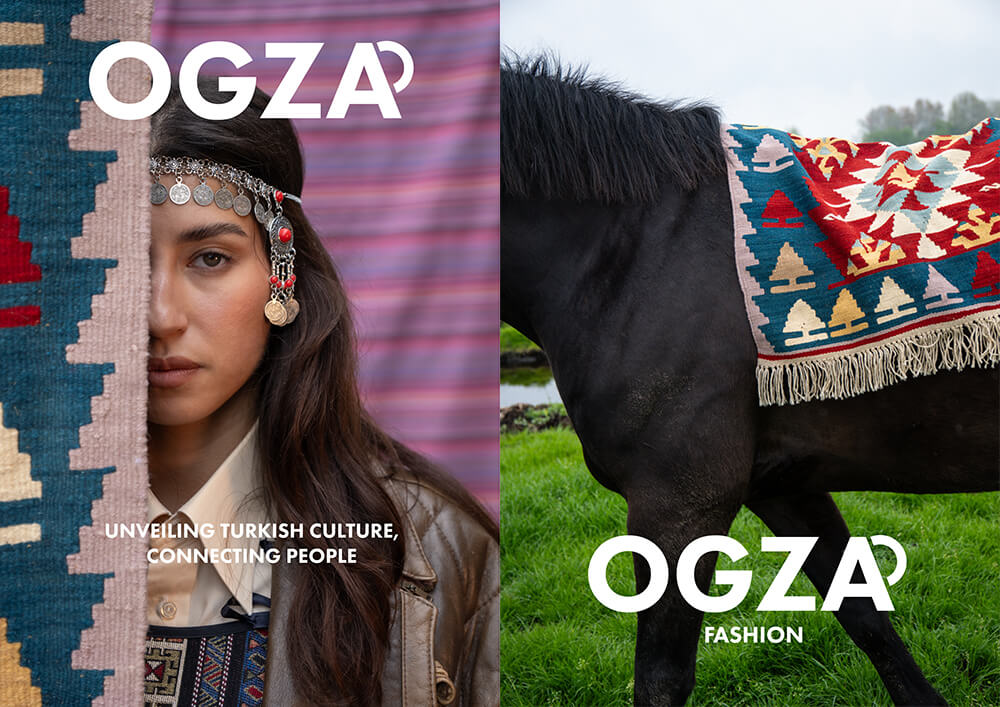
Images of the OGZA Collection; Photo Credit: Coulproductionss / MUAH by urbangems.official
The biggest challenge? Building it all from scratch. Naming, visual identity, tone of voice - every decision carried weight. But Aslinur stayed grounded by returning to the project's purpose: creating something personal yet universal, rooted yet expansive. Now, she’s looking to grow OGZA and to collaborate with brands ready to embrace cultural storytelling, authenticity, and a more emotionally intelligent approach to fashion.
In a world hungry for visibility, OGZA reminds us that fashion can be more...it can also be a homecoming. Or as one anonymous participant said...
''Turkish culture feels like coming home, filled with warmth, hospitality and tradition. A place where I instantly feel welcome, loved and deeply connected.''
Connect with Aslinur here.
3. Lot Laan x Clé de Hermès - Reframing Digital Luxury Through Slowness, Story & Speculation
For Lot Laan, digital innovation isn’t about speed or spectacle - it’s about sensibility. That idea anchors Clé de Hermès, a speculative brand extension for Hermès that reimagines the house’s elusive quota system as an emotionally intelligent, world-building experience.
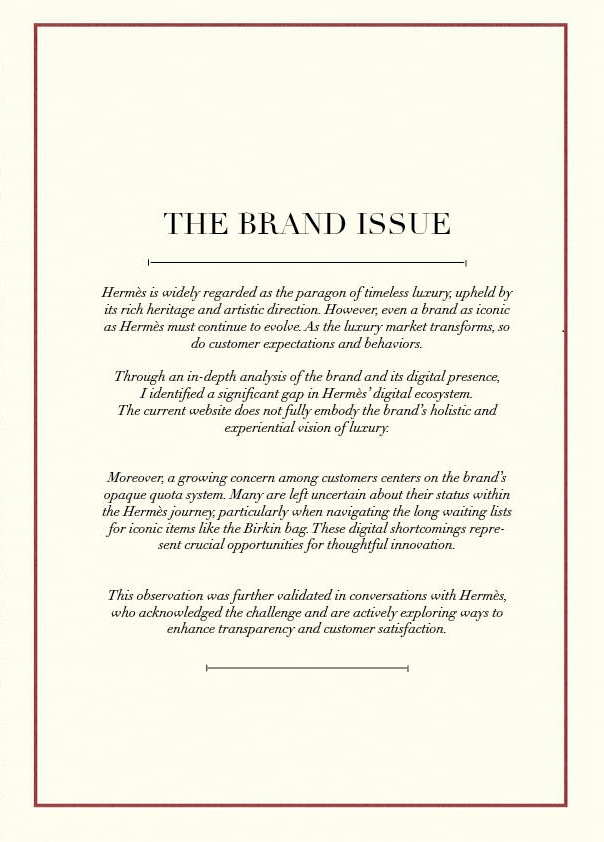
Rooted in the brand’s heritage yet shaped by modern cultural critique, Clé de Hermès proposes a digital-first strategy that culminates in tactile, real-world encounters. Customers would receive a symbolic key - la clé - upon reaching a spending threshold, granting them access to a curated digital platform where their progression unfolds not as a cold queue, but as a mythical journey.
''I imagined myself as a customer with millions in the bank…and I still wouldn’t want to be kept in the dark about my bag.''
What began as a UX critique evolved into something bigger: a challenge to the luxury industry’s “techno-gaze” - the often unimaginative way technology is applied to brand experiences. Lot asked: what if digital didn’t just streamline processes, but unlocked narrative depth, intimacy, and intentionality?
👉 Watch Lot’s speculative campaign film; a surrealist narrative that brings Clé de Hermès to life through symbolism, dreamlike visuals, and emotional storytelling.
Drawing on influences from Hermès du Monde, surrealist art, and philosophical texts like Homo Deus and Technofeudalism, Lot envisioned a hybrid brand world shaped by slowness, symbolism, and sensory storytelling. The result is a multi-layered ecosystem - part platform, part experience - that invites Hermès customers into poetic, emotionally resonant spaces: a garden in Versailles, a lakeside retreat in Udaipur, a mist-covered mountain castle.
''I realised the future of luxury might actually be offline. As digital becomes ubiquitous, it's these rare, analog moments that will feel most meaningful.''
Central to the narrative is Nico, a fictional Hermès customer and modern-day guide whose journey unfolds across this immersive universe. Their gender is intentionally left undefined, creating space for broader identification. Nico, Lot explains, “represents a new kind of Hermès customer: someone raised around luxury, but now seeking experiences that bring personal growth, imagination, and cultural richness.”
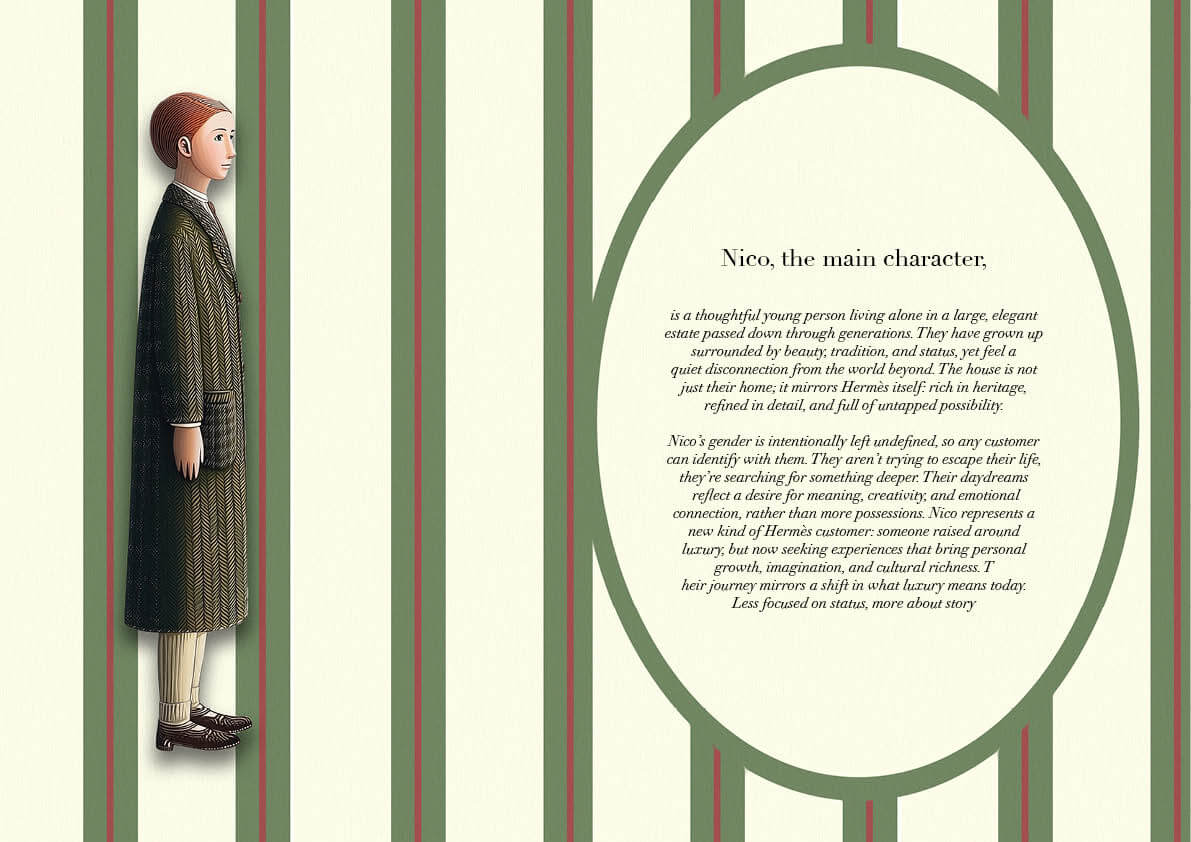
But for all its imagination, Clé de Hermès remains grounded in realism. Lot carefully studied Hermès’ design DNA and history, modelling the concept on the maison’s past publications and brand partnerships. She even proposed a collaboration with French hotel group Lartisien to host the physical elements, ensuring Hermès could deliver the experience without overextending its internal teams.
''Hermès likes things to feel light - that’s why they tend to do short pop-ups. Partnering with Lartisien was a way to respect that rhythm while expanding their brand touchpoints.''
The concept also pushed Lot to rethink how we define technology itself. Initially stuck on the idea of data visualisation, she eventually let go, moving past analytics to build a brand world shaped by emotion and storytelling.
''The learning curve was stepping away from what I knew about tech. I had to reframe it not as the centrepiece, but as the silent engine behind a new kind of luxury.''
Still, Lot recognises that some executives might find the scale of the idea daunting. But for those willing to engage, Clé de Hermès offers more than aesthetic value - it’s a strategic evolution that addresses brand opacity, deepens loyalty, and expands the emotional vocabulary of luxury.
Now graduating from AMFI, Lot is pursuing a final strategy internship before launching a consultancy. The ambition? To help brands explore meaningful innovation at the intersection of heritage, technology, and speculative storytelling.
''There’s so much room for digital innovation - if we stop seeing it through a purely technical lens. That’s where I come in.''
Connect with Lot here.

4. Halimat A. Adekunle - MUGLER X KENNETH IZE: IBEJÌ - Decolonising Fashion Through Digital Futures
What if fashion didn’t just reference African culture, but re-centred it? That question drives MUGLER X KENNETH IZE: IBEJÌ, Halimat Adekunle’s speculative, digital-first campaign concept imagining a radical collaboration between Mugler and Nigerian designer Kenneth Ize. The result is a visionary Afrofuturist world shaped by Yoruba mythology, diasporic identity, and a desire to build systems - not just stories - that reflect Black authorship.
''The digital realm became a sacred archive, a speculative playground, and a mirror of the future I wanted to see.''
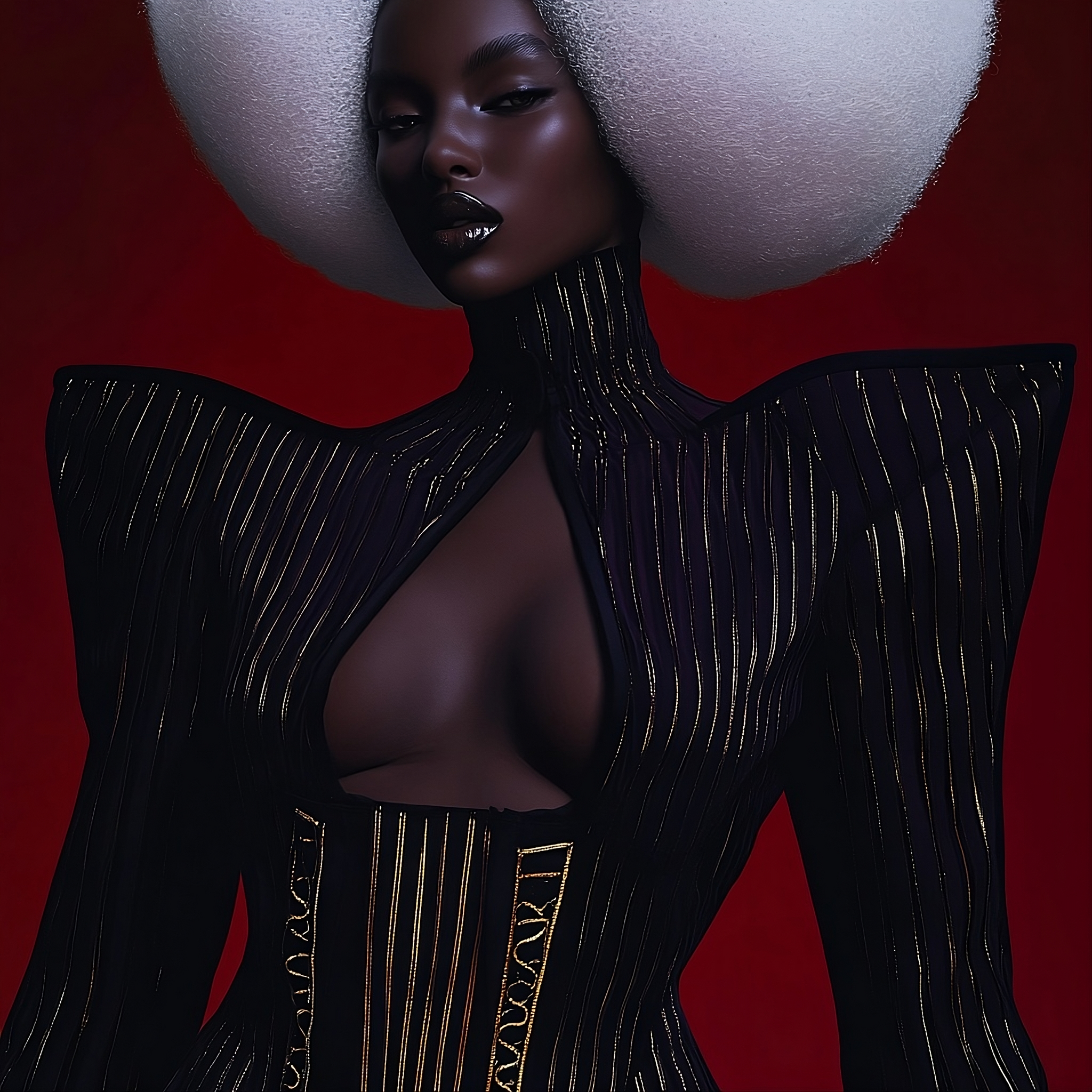
Rooted in the Yoruba twin deity Ibeji, the campaign explores duality - tradition and futurism, heritage and innovation - and challenges the industry’s reliance on surface-level inclusivity. Instead of African culture as aesthetic, IBEJÌ offers it as foundation: spiritually, visually, and politically embedded in every layer of brand storytelling.
Inspired by how music and film have embraced Afrofuturism - think Black Panther to Children of Blood and Bone - Halimat saw fashion lagging behind. Her response was not just critique, but creation: a fully digital campaign comprising a speculative strategy deck, AI-generated imagery, and a behind-the-scenes concept film. Built without access to studio teams or production budgets, the tools she used weren’t just practical but were political.
''Technology became an equaliser, a cultural amplifier, and an essential part of telling an Afrofuturist story that couldn’t exist within the limitations of the physical world.''
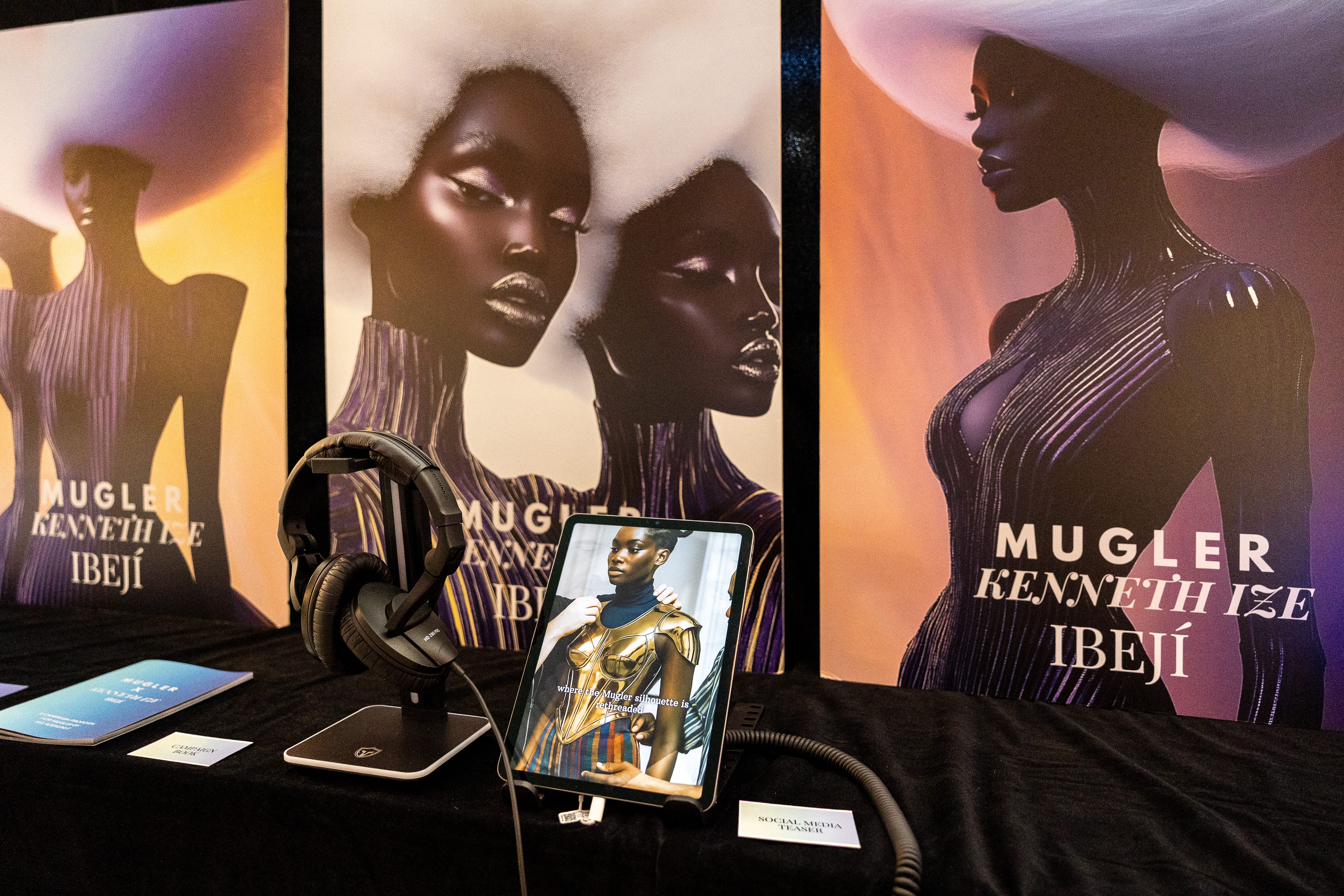
One of her biggest challenges? Overcoming perfectionism and the absence of adequate visual training data for authentic African garments. Refusing to default to familiar tropes like Ankara prints, Halimat set out to digitally visualise the understated luxury of Asooke-inspired silhouettes. The process required iteration, patience, and imagination.
''The learning curve was letting go of what I knew about tech and reframing it as a tool for cultural restoration, not just efficiency.''
At its heart, IBEJÌ questions not just how fashion represents 'Blackness', but who gets to shape the frameworks behind it. It proposes a shift from tokenistic collaboration to cultural co-authorship - what Halimat calls a more emotionally intelligent and equitable approach to brand-building.
''Inclusivity without systemic change is just marketing. We need to work with cultural custodians, not just feature their stories.''
Now graduating from AMFI, Halimat is channeling her vision into the next chapter. She’s building her own brand and open to consultancy roles across DEI, branding, and speculative design, collaborating with teams ready to move beyond “diversity” into something deeper, more structural, and more soulful.
Because for Halimat, this isn’t about trend, but about truth, legacy, and liberation.
Connect with Halimat here.
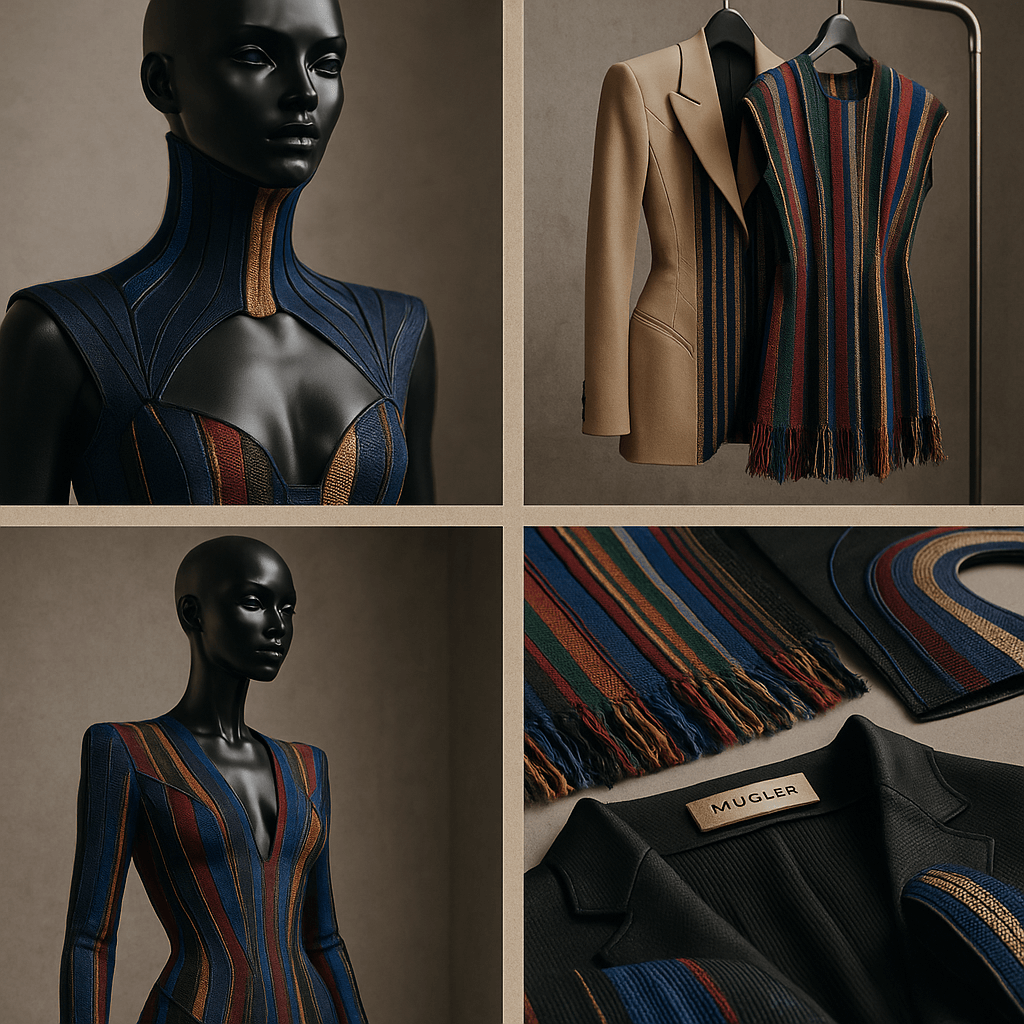
Final Thoughts
What unites these four projects isn’t a shared aesthetic or branding formula, but rather a deep commitment to designing with care, context, and cultural consciousness. Whether through speculative storytelling, intergenerational UX, or identity-driven fashion activism, these graduates are reimagining branding not as a tool for persuasion, but as a medium for connection.
They remind us that brands today can do more than sell; they can amplify overlooked voices, restore cultural nuance, and turn digital platforms into spaces of empathy and meaning.
A huge congratulations to all of AMFI’s 2025 Fashion & Branding graduates - not just the four featured here, but the full cohort who challenged conventions and brought radical thoughtfulness to their final projects. With talent like this stepping into the industry, the future of branding looks more emotionally intelligent, more inclusive, and far more human.
To those reading: whether you're looking to support emerging talent, explore meaningful collaboration, or simply rethink your own branding practice, now’s the time to connect.
The future of brand-building isn’t just bold. It’s intentional, layered, and alive with storytelling.
Editor’s Note: ‘Fashion Futures: Class in Session’ is a Seamless series that dives into the schools, students, and educators reshaping the industry from the ground up. By exploring pioneering programmes, breakthrough research, and the bold ideas of tomorrow’s talent, we uncover how fashion education is evolving to meet the challenges and opportunities of a radically changing world.
Missed the previous instalments of 'Fashion Futures: AMFI Class in Session'? Explore the Design and Management graduate showcases from AMFI’s Class of ’25 now.

